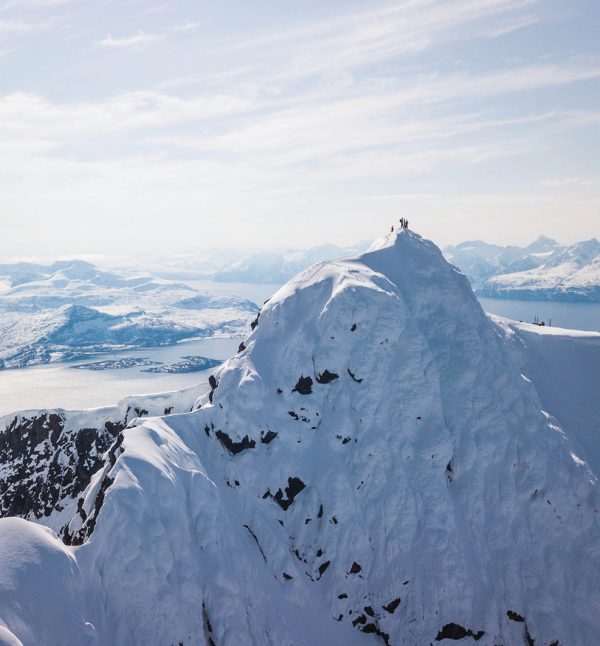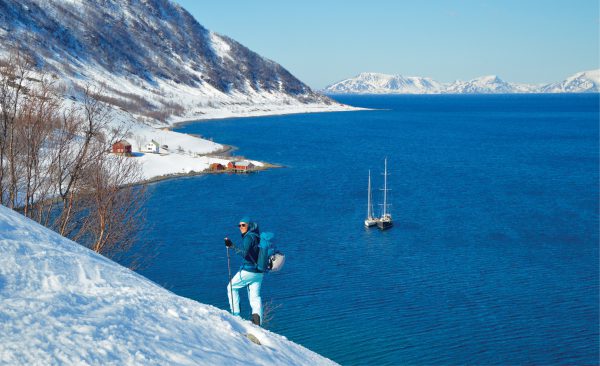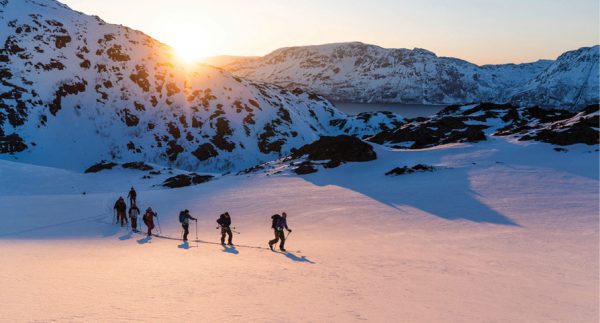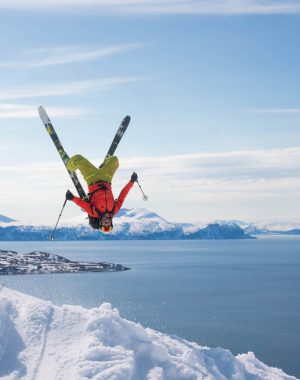Skiing and sailing Norway means practicing avalanche rescues as well as man-overboard drills
Cameron’s and my plan to keep our cabin tidy went awry much faster than anticipated. As the only two sailors on board (apart from our 23-year-old skipper Mats), we agreed when we were assigned our diminutive cabin how important it was to store everything neatly in its place, secure on shelves and hooks or hanging in latched lockers, especially while underway.
By our second night, still clad from the day before in my new seamless Lifa merino baselayers, I was on my bunk happily worming my way into a melee of duvet, cameras and electronics, toiletries, notepads and pens, sailing clothes, inflatable PFD, ski-touring layers, shoes, sailing boots, one ski-boot shell—and being on the bottom bunk, assorted similar stuff of Cameron’s that had tumbled from his mountain that rose from the floor over onto me each time the boat heeled. In the morning I found part of my avalanche shovel handle and probe under my pillow. On this combo skiing and sailing trip, “sleep came easily” was an understatement.
We were in the birthplace of skiing, as recorded 5,000 years ago on some of the area’s thousands of rock carvings. Just sailing and skiing and sailing and… I was in heaven.
A day earlier our troop of 26 writers, photographers, athletes, mountain guides and Helly Hansen execs had left Oslo in the wee hours of a night that doesn’t get dark in May, to fly north to the town of Alta. The almost mythical surrounding region of Finnmárku, or Finnmark, borders Russia to the east and Finland to the south, with Alta, in the centre, sitting at 70 degrees north latitude. That’s way north of Iqaluit, and even north of Tuktoyaktuk for those who know their Canadian geography. We were about 150 km away from Knivskjellodden, the most northern point of Norway proper (and all of continental Europe).
By mid-morning we were milling about Alta’s town jetty, the spring sun in a cloudless sky warming our excited happy faces while a strong breeze off the fjord reminded us we were in the Arctic. As a former editor of Canadian Yachting magazine, I had been wondering how all of us could be accommodated on board two boats, and my concerns only grew when I tallied our mountains of ski bags and gear strewn about.
Lead skipper Emil, who operates the adventure charter company SeilNorge (Sail Norway), welcomed our excited crowd, introducing faces and explaining some basics on safety while I scoped our floating lodgings moored behind him. Although Valiente, a 21-metre custom motor-sailer, had an indoor wheelhouse, hot showers, a dishwasher…generally a warmer, drier and overall bigger boat, her sister Humla, a 15-metre Bavarian 50 sloop, would provide a far more true sailing experience so I realigned myself when we numbered off for the sorting hat to ensure a berth on Humla.
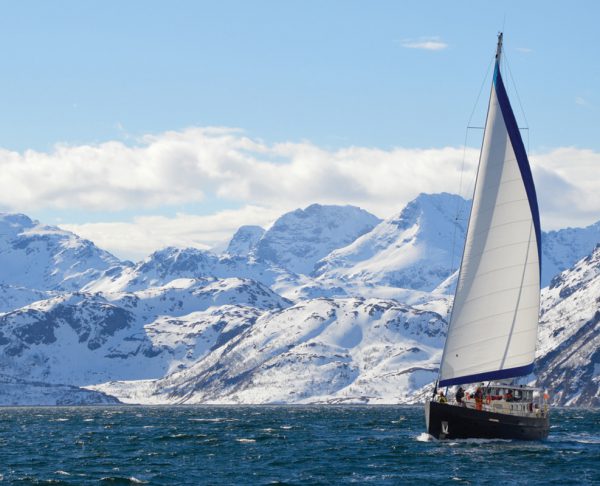
Aside from Cameron and Mats, I would be competing for boot-liner drying space above the engine for five days with mountain guide Vergard, Helly Hansen’s smiley Nordic Marketing Manager Lars and super-smiley ski-athlete Dennis, Swedish Instagrammer Gaby, American outdoors journo John, and fellow Canadian scribes Susan and MIT and Rhodes scholar scientist Kate.
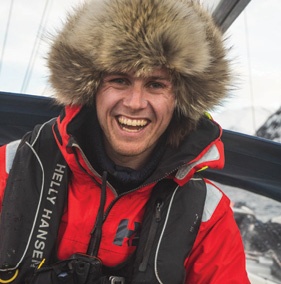
Within minutes of casting off our lines, Mats (investing in his own safety) commissioned me First Mate, handed the wheel over and announced we would be practicing man-overboard drills. He jettisoned a large floaty boat-fender and I quickly realized it drifted away almost faster than my two tonnes of fibreglass, freshwater, humans and their wheeled ski bags tied to the deck could chase. Manoeuvring my new beast, politely yelling orders to people whom I’d just met while Mats yelled at me was both comical and surreal, but I passed, we survived and soon had both the mainsail up, genny unfurled, engine off and a course set to Stjernøya or Star Island.
With a consistent 15-knot wind, virtually no swells given the tight fjords and their enormous snowy alpine walls that were surrounding us, the combo of multiple layers of Lifa and Helly Hansen, and the Norwegian spring sunshine, we were one happy, if hungry cockpit.
Jet lag and our early departure caught up with us just as our sister ship Valiente also did. Her bigger, better-equipped galley, meant Cook and all his mouth-watering meals were on our sister ship and when the time came, they were passed between us. Wearing the chef hat was the coolest Greenlander I’ve ever met. (He’s also the only Greenlander I’ve ever met.) Qaaqqutsiaq, who by a slighter easier to pronounce nickname “Tipi” for some reason, is also head chef at Kreativ Catering in Oslo but regularly joins SeilNorge crews to match the stellar alpine and maritime surroundings with memorable gastronomy. Tipi succeeded.
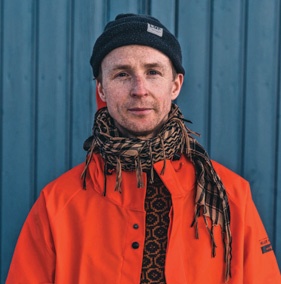
When the two yachts met broadside, trays of locally sourced delicacies, flavours, colours and textures that I’ve never experienced were passed over the rail to great applause before we scurried below like hyenas on a kill. If we were underway at mealtime heading to a new anchorage and trailhead, poor Mats was left topside while our crew huddled around the table below, silent except for the occasional umming and awing as our tastebuds experienced new delights. In Finnmark, more than 180,000 semi-domesticated reindeer roam about, with all husbandry conducted by the native Sámi people. The same species as our Caribou, Scandinavian and Russian reindeer are just a smaller version—and indeed quite tasty.
On our first day we didn’t drop anchor on the northeast point of the Øksfjord peninsula until well after our late lunch. And it was after 6:00 p.m. on our first day before we’d shuttled everyone and their ski gear to shore in our little inflatable dinghies. I had to remind myself it was early May given the strange sight of snow still lying uninterrupted down to the seashore. And here we were, starting our ski day well after 6:00, not finishing it.
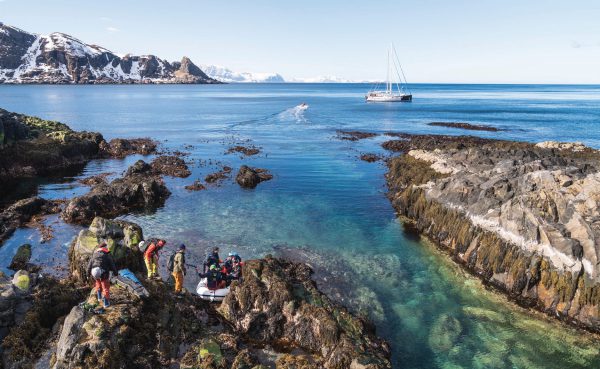
Loahppa, meaning simply “The End” in Sámi, was both inviting and looming but not imposing—a quick 720m skin up before supper. Except our group was more than 20 and boisterous, with cameras, phones, and revving at different speeds and levels. Our father and son guides Tore and Vegard were relaxed, however, and pods of similar skiers managed to find each other quickly. Before long the mesmerizing routine of one foot in front of the other and the zippy sounds of our skins beneath our skis were combined with an increasingly golden and lower sun as we went from corn to firm to winter powder. Supper could wait. So could sleep.
With distant memories of a summer I spent in the north Yukon as a field student, there is no actual night, or “astronomical twilight,” in early May, only a few hours of “civil twilight.” Our sun was officially setting around 10:30 p.m. each evening, getting later by six to eight minutes a day—and rising officially before 2:30 a.m. However, the alpenglow continued well past midnight so there was plenty of opportunity to pull out the camera or phone repeatedly during our first skin-and-ski.
Although much of Scandinavia looks remarkably similar to the rock, lakes and trees of Ontario, it sure doesn’t in northern Norway. I was fascinated thinking how recent in geological time these mountains rose from the sea, thanks to isostatic or post-glacial rebound following the Ice Age’s big melt 10,000 years ago. In fact, they’re still rising up to a centimetre a year as the Earth’s crust finds itself free of a few kilometres of ice that flattened it for 100,000 years.
The next day it was easy to picture the entire Brattnesdalen (steep valley) encased in ice on our tour up the Svartfjelljøkelen, or black mountain glacier, to 1,247m. Where we were hot in the valley, making our way for an hour before the start of the ascent, the vertical rock walls above the glacier brought welcome shade from the sun as well as views of several slides on the opposite side that had quickly heated up. Encouraging and offering ski-touring tips to newbies in the group was rewarding, and I thought again how randonnée is not some gnarly niche reserved for experts-only. Anyone comfortable skiing off groomers and who also doesn’t worry about a long hike beforehand can reap the immense rewards that touring away from the madding crowd offers. These are the ski days you’ll remember for life.
That night we overnighted at the island of Loppa (appropriately translated: “small bug in a big ocean”), one of many ghost-like fishing outports with reflections of Newfoundland. With only two permanent year-round inhabitants left in Loppa, we learned the tidy houses were kept up because of summer residents—northern Norwegian cottage life. While brushing my teeth before bed, I watched a freighter off in the distance—evidently with a course set for Russia.
Another bluebird day greeted our high-pressure trip the next morning, and a new shoreline of crystalline aqua waters and grotto-like shoreline fringed in seaweed welcomed us. Well below the snowline, we strapped skis to our backpacks to begin a hike in the heather. Someone planted an earworm of the Sound of Music soundtrack in my brain that I couldn’t help singing as we made our way up the valley Skjerdingdalen. A bootpack followed and finally a lovely skin along a ridge toward Stølfjellet, which I was told meant either “summer farm” or “muscle soreness mountain.”
After a Norwegian brown cheese, lettuce and lingonberry jam sandwich (my creation, not Tipi’s), I joined half the group that took off en masse on a wide-open, spectacularly smooth high-speed cruising run, with occasional stops for crazies like Philip and Dennis to set up Instagram and Facebook backflips. The speedometer remained cranked right onto the flats as our whooping and hollering group hopped rushing streams of winter melt, rocks, bushes and bare patches until we reached the rocky seashore. Our hike back to the dinghies took almost an hour, partly from the distraction of flotsam lying about the craggy and blustery shore from far-off places, including an orphaned scientific-data-gathering oceanographic buoy from Nova Scotia.
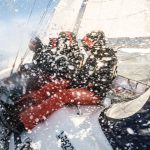
On our earlier stroll up Stølfjellet and the enormous views it offered I had noticed first the white caps and then the rollers of a changing sea far below; the winds had picked up noticeably. With some big open water sailing to be done to reach our next landfall, I strategically accepted an offer to switch boats for a few hours when several people had asked. Inside the warm and dry wheelhouse of our sister boat Valiente, I held onto grab rails overhead and watched the anemometer bounce up to 40 knots as walls of water crashed over the deck on our bouncy ride. For a couple of hours there was nothing between us and Greenland. My fellow crewmates reported dryly that my absence had been noted while the ocean was slapping their faces. Thankfully, Helly Hansen has had 141 years of gear testing in northern waters and everyone was forgiving when I boarded again in Jekthamna that evening.
It would be another outstanding day of skinning up and skiing down from the 1,230m Mount Crumpet-like peak of Store Kågstinden before sailing hours to the vibrant little Arctic city of Tromsø, arriving well after midnight. Despite the energy that 24-hour light seems to provide the body, I had a prior engagement with my duvet et al and wasn’t able to join the younger set who headed out to the nightclub around 2:00 a.m. I’ve always been one who has the sleep requirements of those on the lower end of the spectrum and can count the number of daytime naps I’ve ever had in my life on one hand. But the week had suddenly caught up with me. On a very full Air Canada flight home from Copenhagen, I had the rare opportunity to be bumped up to business class but unfortunately I remember little about the service. I slept, smiling, almost the entire way home.
by IAIN MACMILLAN in Fall 2018 issue
THE WAY TO NORWAY
Air Canada flies daily to Copenhagen and Frankfurt from Toronto and codeshares with SAS onward to Oslo, Alta and Tromsø.
SeilNorge offers individuals or groups several Ski & Sail 2-7-day itineraries from late March to early May, as well as custom trips including bareboat chartering. sailnorway.com
Finnmark mountain guides: VegardKarlstrøm@yahoo.com
Read up first: With at least nine guidebooks published in English, ski-tour and travel Norway from your armchair before you go: friflytbestill.no
